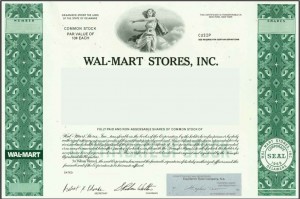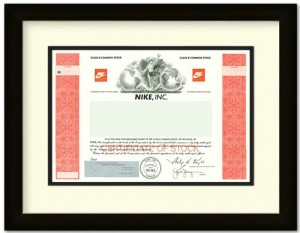
How to Find Investment Ideas
Years ago, I wrote an article called Finding Investment Ideas for Your Portfolio for About.com, a division of The New York Times. I’ve been thinking for the past few days about how it is that I seem to come across so many opportunities and then I realized that most people like me are always looking whereas the average American isn’t.
By that, I mean that every time I walk into a business, without exception, the first thought that occurs to me as I look around is, “I wonder if this company is publicly traded.” If it looks promising, I add it to a mental list and during my regular research periods each week, I pull all of the information I can about the company, or the corporate parent, and begin attempting to value it conservatively. It only takes a few, or even one, great investment in a lifetime to be financially independent.
If my friends and family could actually hear my thoughts, it would be amusing. As we walk through the aisles of Wal-Mart, I am thinking to myself, “Wal-Mart has a net profit margin of 3.3%. So, if I buy this $49.95 video game, the stockholders, who are the owners, are going to generate after-tax profit of $1.65 on the sale. With a dividend payout ratio of roughly 30%, $0.50 of that will be distributed as a cash dividend and the remaining $1.15 will go toward expansion or stock buybacks. With 3,810,171,967 shares of stock outstanding, each share of the company is entitled to $0.000000000433051 of the profit.” Sometimes, I actually pull out a calculator to compute figures as I stroll besides the shopping cart.
It’s almost like a game of chess, or solving a puzzle where the pieces are constantly moving and half of the box is missing. I love the game. Particularly, I like that if I’m right, I make money for the people about whom I care, so they can buy nicer clothes, pay off their debt, take vacations, or send their kids to music lessons. That matters to me far more than the idea of owning a Net Jet. It provides me with a real sense of satisfaction. Most people can’t say they actually make a difference in people’s lives. I can.
Yet, this idea of looking for such opportunities never occurs to most people. Here’s an example from my own family …
Ed’s Sporting Goods: An Example In My Own Family
Members of my extended family owned a business called Ed’s Sporting Goods that at one time was the largest sporting goods retailer and team dealer in Northwest Missouri. Now, it was a successful business – far more successful than the average entrepreneur and something about which the owners are, and rightfully should be, proud.
I remember going out to lunch with my Grandma Kathryn at a local Chinese restaurant (we’ve done that since I was a kid whenever we’re both in town) and talking about stocks. She said that for years she had been thinking about buying shares of stock in Dollar General but had just never gotten around to it. I understood this perfectly because I had done the same thing with Apple (despite making a ton of money on companies such as American Eagle Outfitters, I stood by and watched Apple skyrocket 1,400% without buying a single share, even though I switched from PC to Mac both personally and at my businesses, knew how well it was doing, and greatly admired its management team!).

Anyway, a few days later, this got me thinking about how we often ignore what is right in front of our face because we are familiar with it. During its 25+ year rise, Ed’s Sporting Goods was a huge dealer of Nike products, from shoes to apparel. I started working on the math and asked myself, “What if they had taken just a tiny amount of the cash – even as little as what they spent on a part-time employee, and had instead regularly bought shares of this company that they knew, from first hand experience, was doing very, very well?” I don’t remember the exact result, but I figured that my Grandmother and Uncle walked away from somewhere north of $4 million by missing that opportunity.
Why? People aren’t taught to look for those opportunities unless they come from wealthy families which, at that point, we were not. They also missed Wal-Mart, which placed two of its first 150 stores in St. Joseph and Warrensburg, where some of the first Ed’s Sporting Goods were! Walton’s company was literally a start-up right alongside their retailer, in the same city, and they shopped there personally. The same thing with Microsoft. The store, due to its screen printing business, was one of the first to adopt Microsoft DOS and later, Windows 3.1. The same goes for Rawlings Sporting Goods, which is now part of Berkshire Hathaway. And Blue Chip Stamps, which my dad said they used in California all the time, which is now part of Berkshire Hathaway. And Benjamin Moore, which operated a store next door, and is now part of Berkshire Hathaway. And Champion apparel. And Reebok. And Pepsi, which apparently my Grandfather drank all the time. The list goes on and on … but it shouldn’t be depressing, it should be exciting that every few years, we are all presented with more investing opportunities.
The Bottom Line
The bottom line of this is to point out that we are all surrounded by opportunity all the time. Here’s the million-dollar question (literally): How many people do you know who actually devote hours each day to identifying and then acquiring those opportunities? Most people would rather spend time studying new washer and dryer models, upgrading their furniture, or reading the sports pages.
There’s nothing wrong with that. But if you spend more hours each week planning on spending money, such as looking at new cars or houses, than you do planning on how to acquire more cash-generating assets, the result is going to be a drastic reduction in your standard of living. This pattern seems to be playing out with a lot of my friends from college who now seem to realize that you aren’t successful because you have the house, or you have the car, or you have the clothes. Those are merely by-products of having the wealth, which (again) consists of cash-generating assets.
Update: I’ve written an update as of April 16, 2014 detailing how this missed opportunity has now cost them at least $8 million.


